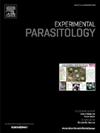Structural and functional implications of MIT2 and NT2 mutations in amodiaquine and piperaquine resistant Plasmodium berghei parasites
IF 1.6
4区 医学
Q3 PARASITOLOGY
引用次数: 0
Abstract
Long-acting drugs, amodiaquine (AQ), lumefantrine (LM), and piperaquine (PQ), are vital components of artemisinin-based combination therapies (ACTs) for malaria treatment. However, the emergence of partial artemisinin-resistant parasites poses significant challenges, particularly in malaria-endemic regions. Despite extensive research, parasite's resistance mechanisms to these drugs still need complete elucidation. This study investigated the genetic basis of resistance to AQ, LM, and PQ using Plasmodium berghei, focusing on selected genes encoding transport proteins in Plasmodium species. In silico bioinformatics tools were used to map genes encoding transport proteins, their ligand-binding sites, and their conservation across different Plasmodium species. PCR amplification and sequence analysis were employed to examine single nucleotide polymorphisms (SNPs) in the genes encoding the selected transporters in AQ, LM, and PQ-resistant P. berghei. The structural impacts of the mutations were evaluated using AlphaFold, ITASSER, UCSF Chimera, and MOTIF Finder. Genes encoding CorA-like Mg2+ transporter protein (MIT2), nucleoside transporter 2 (NT2), ABC Transporter G family member 2 (ABCG2), and novel putative transporter 1 (NPT1) transport proteins with notable conserved motifs and ligand-binding motifs in Plasmodium species were selected and examined. In AQ-resistant (AQR) parasites, a non-synonymous mutation (I433∗) was found in MIT2. PQ-resistant (PQR) parasites possessed a non-synonymous mutation (D511H) in NT2 and a silent mutation in the NPT1 protein. No mutations were observed in the targeted regions of the transporters in LM-resistant (LMR) parasites, nor in the ligand-binding motifs of ABCG2 across all resistant strains. These findings suggest that selection pressure from AQ and PQ leads to mutations in MIT2 and NT2. Further investigation is required to understand how these mutations affect drug susceptibility on a functional level.

耐阿莫地喹和哌喹柏氏疟原虫MIT2和NT2突变的结构和功能意义
长效药物阿莫地喹(AQ)、甲苯曲明(LM)和哌喹(PQ)是治疗疟疾的以青蒿素为基础的联合疗法的重要组成部分。然而,部分抗青蒿素寄生虫的出现构成了重大挑战,特别是在疟疾流行地区。尽管有广泛的研究,但寄生虫对这些药物的耐药机制仍然需要完全阐明。本研究对柏氏疟原虫(Plasmodium berghei)对AQ、LM和PQ抗性的遗传基础进行了研究,重点研究了疟原虫中编码转运蛋白的基因。在硅生物信息学工具被用来绘制编码转运蛋白的基因,它们的配体结合位点,以及它们在不同疟原虫物种中的保守性。采用PCR扩增和序列分析的方法检测了AQ、LM和耐pq的伯格黑螺旋体中选定转运体编码基因的单核苷酸多态性(snp)。利用AlphaFold、ITASSER、UCSF Chimera和MOTIF Finder对突变的结构影响进行评估。选择并检测了疟原虫中编码cora样Mg2+转运蛋白(MIT2)、核苷转运蛋白2 (NT2)、ABC转运蛋白G家族成员2 (ABCG2)和新型转运蛋白1 (NPT1)转运蛋白的基因,这些转运蛋白具有显著的保守基序和配体结合基序。在抗AQR (AQR)寄生虫中,在MIT2中发现了一个非同义突变(I433*)。PQ-resistant (PQR)寄生虫具有NT2的非同义突变(D511H)和NPT1蛋白的沉默突变。在所有耐药菌株中,在lm耐药(LMR)寄生虫的转运体靶区和ABCG2的配体结合基元中均未观察到突变。这些发现表明,来自AQ和PQ的选择压力导致了MIT2和NT2的突变。需要进一步的研究来了解这些突变如何在功能水平上影响药物敏感性。
本文章由计算机程序翻译,如有差异,请以英文原文为准。
求助全文
约1分钟内获得全文
求助全文
来源期刊

Experimental parasitology
医学-寄生虫学
CiteScore
3.10
自引率
4.80%
发文量
160
审稿时长
3 months
期刊介绍:
Experimental Parasitology emphasizes modern approaches to parasitology, including molecular biology and immunology. The journal features original research papers on the physiological, metabolic, immunologic, biochemical, nutritional, and chemotherapeutic aspects of parasites and host-parasite relationships.
 求助内容:
求助内容: 应助结果提醒方式:
应助结果提醒方式:


